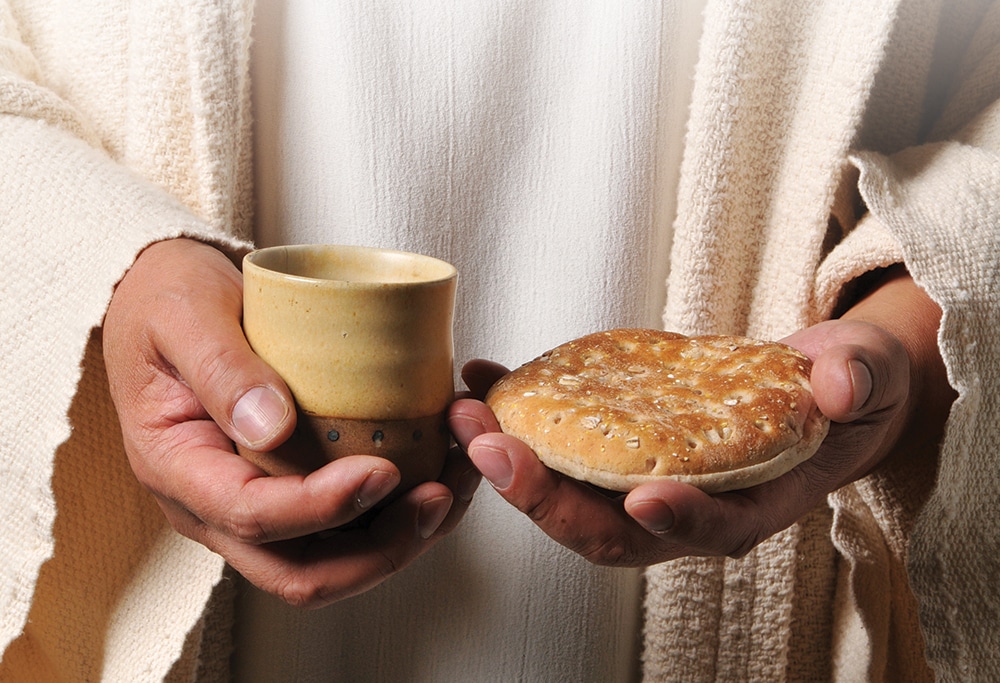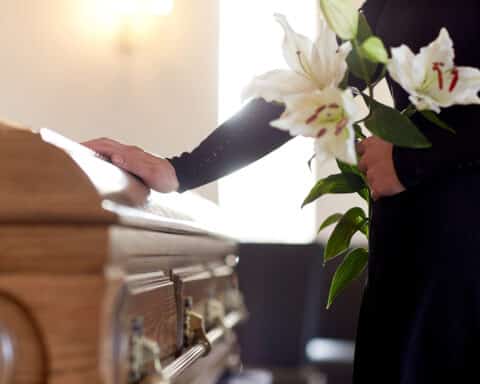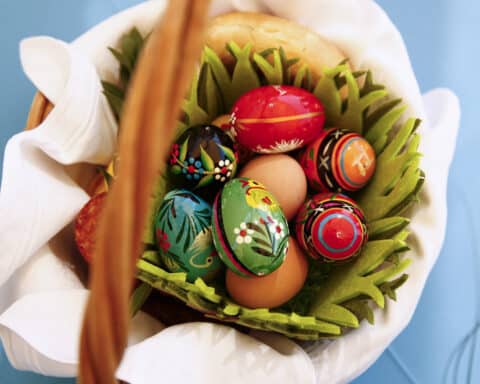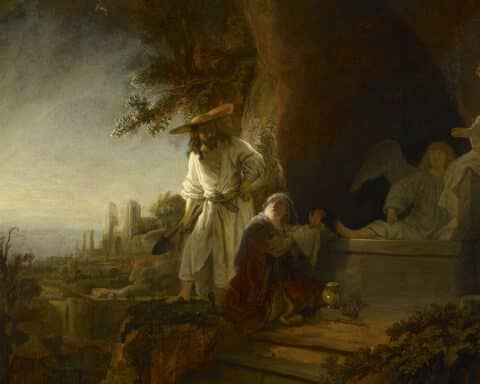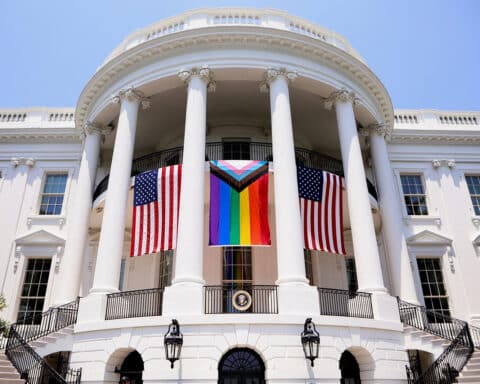Few days on the Church calendar are more beautiful or filled with more meaning than the Thursday of Holy Week, the beginning of the Easter Triduum. During these three solemn days we relive the passion, death and resurrection of our Lord, Jesus Christ — three days that are central to Christianity.
The first of these Triduum days is Holy Thursday, which celebrates the Last Supper when Jesus instituted the Eucharist and the priesthood, washed the feet of the Twelve Apostles and gave a new commandment. He would then spend time anguishing in the garden about the events of the next day, be betrayed by a friend, arrested, denied by another friend, shuttled between accusers, condemned by the Jewish high court and, finally, although innocent, found guilty of sedition by Pilate.
D.D. Emmons writes from Pennsylvania.
The Passover
The day seemed to have a normal beginning, with everyone preparing for a celebration. In the Jewish world in which Jesus lived, what we call Holy Thursday was the celebration of the Passover.
Every year, in accordance with God’s command, Jews commemorate the night when the Lord passed over the firstborn Israelites while striking down those of the Egyptians. This was at the time when Moses, at the Lord’s command, prepared to lead the Israelites out from Egyptian bondage (cf. Ex 12). The Lord told Moses not to forget the Passover act, his sparing of the Israelites: “This will be a day of remembrance for you, which your future generations will celebrate with pilgrimage to the Lord; you will celebrate it as a statute forever” (Ex 12:14).
Twelve hundred years later, on the Wednesday before the Passover celebration, Jesus sent two of his apostles to Jerusalem to confirm the location where he and all the apostles would make a pilgrimage to eat the annual Passover meal. The apostles were told exactly where to go, who to see and instructed to make the necessary preparations.
As Pope Benedict XVI wrote in his book of Lenten reflections, “Journey to Easter”: “The Hebrew Pasch [Passover] was and is a family feast. It was not celebrated in the Temple but at home. … Jesus too, celebrated the Pasch in compliance with the prescription: at home with his family, for the apostles had become his new family. … And so the Pasch has become a Christian feast also.”
The Passover meal always took place in the evening after sunset, because in the ancient Jewish world a new day began at sunset not at midnight. This Jewish custom originated from the Old Testament Book of Genesis 1:5: “God called the light ‘day,’ and the darkness he called ‘night.’ Evening came, and morning followed — the first day.” Thus, the Last Supper was held on the evening of the first of three days that included his passion, death and resurrection.
He told his apostles: “‘I have eagerly desired to eat this Passover with you before I suffer, for, I tell you, I shall not eat it [again] until there is fulfillment in the kingdom of God. … I shall not drink of the fruit of the vine until the kingdom of God comes” (Lk 22:15-18). Our divine Lord Jesus knew this was his last meal before his passion.
Washing of the feet
The Passover meal was eaten in a special way as described in Exodus 12. There was roasted lamb, unleavened bread and bitter herbs. Wine was included, and the meal was broken into several courses.

The Gospel according to John tells that during the meal Jesus got up and washed the feet of the apostles. This was a hospitality duty, a menial task normally carried out by a slave: “So, during supper, fully aware that the Father had put everything into his power and that he had come from God and was returning to God, he [Jesus] rose from supper and took off his outer garments … and began to wash his disciples’ feet and dry them with the towel around his waist. … He said to them, ‘Do you realize what I have done for you? You call me ‘teacher’ and ‘master’ and rightly so, for indeed I am. If I, therefore the master and teacher, have washed your feet, you ought to wash one another’s feet'” (Jn 13:2-5, 12-14).
Since the meal already had started, the apostles would have previously had their feet washed; thus, this act of Jesus was a demonstration of humility. He had likely cringed when he previously heard his apostles arguing about who was the greatest among them; now he would demonstrate not only how much he loved them, but how they should serve and love one another with charity and humility.
In his “Lecture on the Gospel According to John,” St. Augustine said: “We have learned, brethren, humility from the highest: Let us, as humble, do to one another what he, the highest, did in his humility … nor should the Christian think it beneath him to do what was done by Christ. For when the body is bent at a brother’s feet, the feeling of humility is either awakened in the heart, itself, or is strengthened if already present.”
Christ included Judas in the foot washing, knowing full well that Judas was going to betray him. The betrayer soon departed to carry out his evil act.
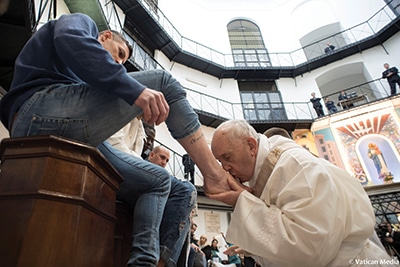
Jesus then tells the other apostles that he will be with them only a short time longer and gives them a new commandment: “Love one another. As I love you, so you also should love one another. This is how all will know that you are my disciples, if you have love for one another” (Jn 13:34-35). He later reiterates, “No one has greater love than this, to lay down one’s life for one’s friends” (Jn 15:13). They are his friends, and the next day he will give up his life for them and for mankind.
The Catechism of the Catholic Church reads: “Knowing that the hour had come to leave this world and return to the Father, in the course of a meal he washed their feet and gave them the commandment of love. In order to leave them a pledge of this love, in order never to depart from his own and to make them sharers in his Passover, he instituted the Eucharist as the memorial of his death and Resurrection, and commanded his apostles to celebrate it until his return; ‘thereby he constituted them priests of the New Testament'” (No. 1337).
Eucharist and priesthood
It is at this meal that Christ instituted the holy Eucharist, the Mass. In each of the Gospel renditions, he blessed the bread and the wine during the meal, gave it to them saying, “This is my body, this is my blood.” Christ truly is present. He adds in the Gospel of Luke, “Do this in memory of me” (Lk 22:19). The apostles, through the bishops and priests of today, continue this sacred action at every Mass.
This is also the moment at the Last Supper when he instituted the priesthood by giving his priests, the apostles, this responsibility. In St. Paul’s First Letter to the Corinthians, Paul repeats the words of Jesus: “And, after he had given thanks, broke it [bread], and said, ‘This is my body that is for you. Do this in remembrance of me'” (11:24). Paul uses almost identical language regarding the cup: “This cup is the new covenant in my blood. Do this, as often as you drink it, in remembrance of me. For as often as you eat this bread and drink this cup, you proclaim the death of the Lord until he comes” (1 Cor 11: 25-26).
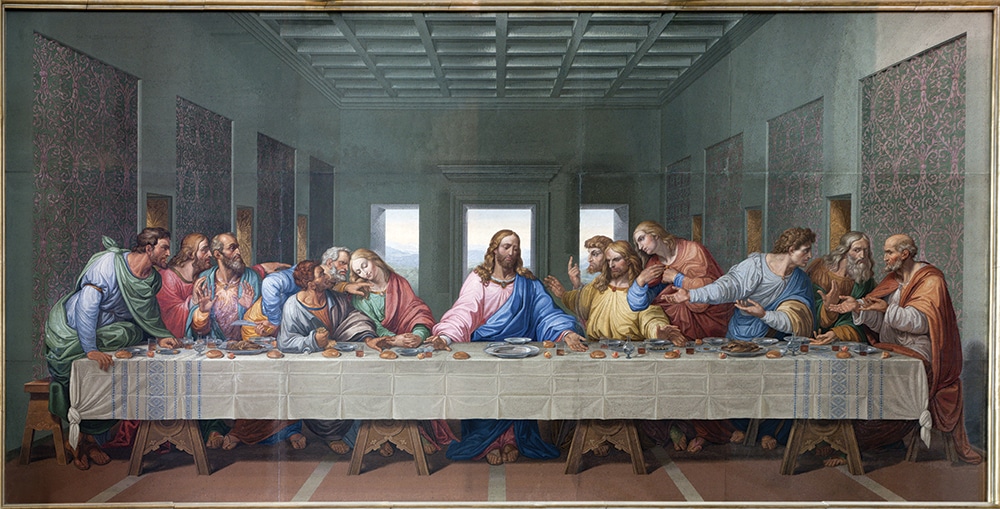
Pope St. John Paul II, in Dominicae Cenae, a letter to the bishops about the Eucharist, wrote that the priesthood “effectively came into being at the moment of the institution of the Eucharist” (No. 2). Many Catholics are not aware that Jesus instituted the priesthood during the Last Supper.
Agony in the garden

After they had finished the Passover meal, Jesus and his apostles went to the Mount of Olives, stopping at the Garden of Gethsemane. Here Jesus went off on his own to pray, leaving the apostles to wait for him. “Remain here,” he said, as if he wanted to avoid them seeing him agonizing over what was going to happen. In his humanity, Our Lord is filled with anxiousness, sadness and fear of the future, but eventually he accepts whatever his Father has chosen for him: “Not what I will but what you will” (Mk 14:36). Three times Jesus goes back and forth between where the apostles are waiting and his prayer spot. Each time he finds the apostles asleep. Even though he had told them that on the next day he would suffer, that even now he was distressed and in agony, his friends slept. Eventually this scene is interrupted by a group of people, including Judas, coming out to arrest Jesus. Judas gave him up with a kiss: “Jesus said to him, ‘Judas, are you betraying the Son of Man with a kiss?'” (Lk 22:48).
The arrest
Jesus first is taken to the house of the high priest, Annas — a courtesy because Annas is no longer the sitting high priest but the most senior priest. Annas quickly sends Jesus to Caiaphas, the current high priest.
At this time Peter is waiting outside and warming himself by a fire when he is confronted by a woman saying that Peter was a follower of Jesus. Peter responds, “Woman, I do not know him” (Lk 22:57). Peter will deny association with Our Lord three times, just as Jesus predicted. Jesus’ closest followers deserted him. St. Peter Julian Eymard wrote in “The Real Presence”: “Jesus Christ was outlawed. His people disowned him and calumniated him; he did not say a word in self-defense.”
Caiaphas, along with members of the Jewish high court, the Sanhedrin, interrogate Jesus at length, and when Jesus compares himself to God, he is accused of blasphemy (Mk 14:55-65). Under Jewish law the penalty for blasphemy is death, but only Pilate, the Roman governor, could sentence someone to death.
The Jews knew Pilate was unlikely to condemn Jesus for breaking one of their Jewish rules. So they accused Jesus of rebellion against the Roman government and opposing the payment of taxes to Caesar. Finding out that Jesus is a Galilean, Pilate sends Jesus to Herod because Herod’s jurisdiction included Galilee.
Herod mocks and ridicules Jesus and then returns him to Pilate, who finds Jesus innocent to the charge of sedition and is ready to release him. Yet the Jewish mob threatens Pilate, saying that they will complain to Caesar if Jesus is released. This had happened in the past, and Pilate didn’t need grief from Rome, so he caved to the mobs’ demands, and “he handed him over to be crucified” (Jn 19:16)
All this happened on the Passover, which we commemorate on Holy Thursday.
Mass of the Lord’s Supper
For this special Holy Thursday Mass, there is preparation that takes place at the parish, at the diocese and by parishioners. In the parish, the place for the altar of repose is identified and decorated. At the diocese, planning for the Chrism Mass includes participation by the bishop and all the diocesan priests. Parishioners prepare by arranging their schedule so that they can attend this mid-week Mass, the beginning of the Pascal Triduum. Doing so, the faithful acknowledge what is in their hearts, in the forefront of their minds — that is, the Passion of Christ. The Church long has encouraged us to prepare our hearts in such a way for every Mass.
The Mass of the Last Supper on Holy Thursday was celebrated in Eastern Church as early as the fourth century and by the seventh century in the Roman Church. Around the 16th century, the bells were rung during the Gloria to acknowledge our joy that the Savior gave us the Sacrament of the Eucharist. The bells are not be rung again until the Easter Vigil.
Historically, washing the feet was sometimes part of the Mass and sometimes not. It was a tradition to wash the feet of 12 men on Holy Thursday, but it was not always included in the Mass. During the 20th century the practice had greatly deteriorated. In 1955 as part of the Holy Week reforms of Pope Pius XII (r. 1939-58), the foot washing was again included in the Mass but made optional. If done during the Mass, the foot-washing ritual takes place right after the homily. This is the direction today, only those chosen are not just men but representatives of the entire community.
Entering the church on Holy Thursday, we quickly notice that the tabernacle is empty. All Communion bread for that night will be consecrated during this Mass. Actually, enough Communion hosts will be consecrated for both tonight and for the following day’s Good Friday service. Good Friday is the only day of the year when there is no Holy Sacrifice of the Mass, but as part of the Good Friday services those worthy may receive holy Communion.
At holy Communion during the Mass of the Last Supper, as is the case at every Mass, we receive the body and blood of Christ just as those apostles did on that night in the Upper Room. But now, instead of the apostles, it is you and I who stand or kneel in his Real Presence. It is the priest, acting in the person of Christ, who breaks the bread, blesses the bread and the wine and gives it to us using the same words that Christ used at the Passover meal: “This is my body; this is my blood.”
During this Mass, we attempt to recollect that we are part of this great legacy and continue this night to celebrate the sacrament he instituted all those centuries ago. We can experience this miracle, this sacred expression of his love. In this demonstration of love, we become what we eat and, like the apostles, this mystery and miracle of the Eucharist overwhelms us.
In his homily on Holy Thursday, the priest celebrant is instructed: “Careful attention should be given to the mysteries which are commemorated in this Mass: the institution of the Eucharist, institution of the priesthood, and Christ’s command of brotherly love; the homily should explain these points” (Circular Letter Concerning the Preparation and Celebration of the Easter Feasts, 1988). We listen to not only the readings from Exodus, Corinthians and John, but the well-chosen words and focused explanation of the celebrant.
Mass on this night often is crowded, as there is only one Mass on Holy Thursday, and even though it’s not a holy day of obligation, parishioners come to celebrate both the significance of this particular Mass and the beginning of the Pascal Triduum. The Pascal Triduum — three seamless holy days — is a continuous celebration, a commemoration of the events that took place in the days of Christ’s passion. There is no final blessing, no concluding rite following the Mass on Holy Thursday and none at the end of the Good Friday service; the Triduum continues.

After the post-Communion prayer Thursday night, the ciborium containing the consecrated hosts for Good Friday Communion is processed reverently to the altar of repose. The procession typically includes clergy, servers and ministers carrying the cross, incense and candles leading the faithful, who may also carry candles, to the place adorned for the Blessed Sacrament to remain until Good Friday. Pope Benedict XVI explained this procession in his Corpus Christi homily, May 26, 2005: “There is also a Eucharistic procession on Holy Thursday, when the Church repeats the exodus of Jesus from the Upper Room to the Mount of Olives. … It is the authentic desire of the Church in prayer to keep watch with Jesus, not to abandon him in the night of the world, on the night of betrayal, on the night of the indifference of many people.”
The altar of repose usually is located on a side chapel or somewhere outside the normal worship space. During the solemn procession, a song such as “Pange Lingua” is sung, and upon reaching the altar of repose “Tantum Ergo” is sung as the priest incenses the Blessed Sacrament. The tabernacle with the Eucharist is then closed, the Blessed Sacrament is not exposed and the faithful remain, “keeping watch” until later in the evening. At midnight the attention of the Church changes from one of keeping watch to reflecting on the passion of the Lord and Good Friday.
The U.S. Conference of Catholic Bishops’ Manual of Indulgences grants a plenary indulgence to those who “piously recite the verses of the ‘Tantum Ergo’ after the Mass of the Lord’s Supper on Holy Thursday during the solemn reposition of the Most Blessed Sacrament.” Also, a plenary indulgence is granted to the faithful who “visit the Blessed Sacrament for adoration lasting a least a half hour.” In both cases, Catholics must satisfy the other requirements for a plenary indulgence.
Stripping of the Altar
Following the placement of the Blessed Sacrament on the altar of repose, the stripping of the church altar begins. Everything that can be reasonably removed is moved from the sanctuary; furniture, candles, altar cloths are removed, and any statues and crosses remaining are covered. In the past, the altar was washed with wine and water, making it as pure as the Lamb of God. The intent is to leave the sanctuary bare, causing us to recall that Jesus was stripped of his garments and, further, that on the night of the Passover he was abandoned, left alone. It is meant to be a sign of mourning. Psalm 22 is often sung or read during the stripping of the altar, which includes the words “My God, my God, why have you abandoned me? … They divide my garments among them; for my clothing they cast lots” (Ps 22: 1, 19). This ritual has been carried out since the seventh century.
| Maundy Thursday |
|---|
|
There has been a long tradition of calling Holy Thursday “Maundy Thursday.” Maundy meaning a mandate or a commandment. After washing the feet of his apostles, Jesus said, “I am giving you a new commandment: ‘love one another.'” The connection of feet washing with Christ’s new commandment is explained in the book “Lent and Holy Week in Rome” compiled by Father William Whitmee, PSM: “In the imitation of our Blessed Redeemer, Christians, popes, kings, bishops, superiors of religious houses and others, wash the feet of some poor person or of their colleagues and fellows on this day, which ceremony is called the Mandate, from the first word of the first anthem of it: Mandatum novum do vobis, etc. Hence this day is called in English, Maundy or Mandy Thursday.”
|

